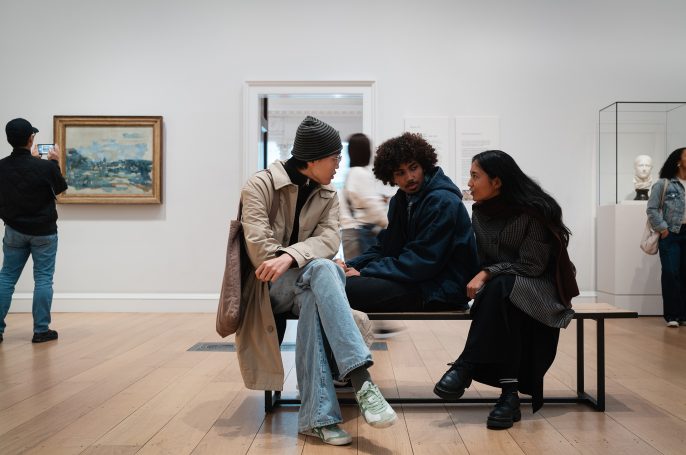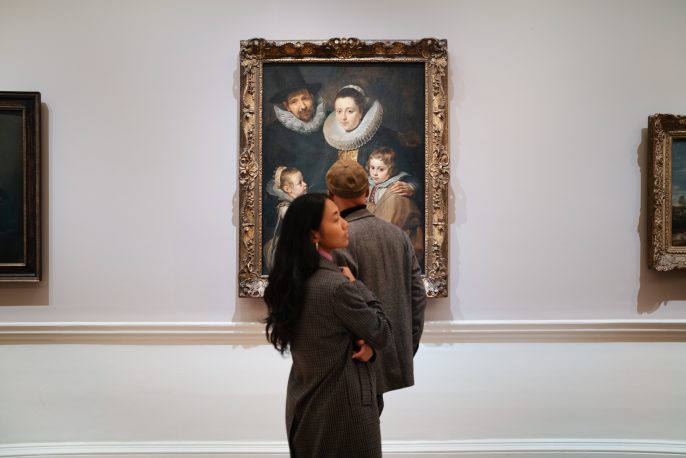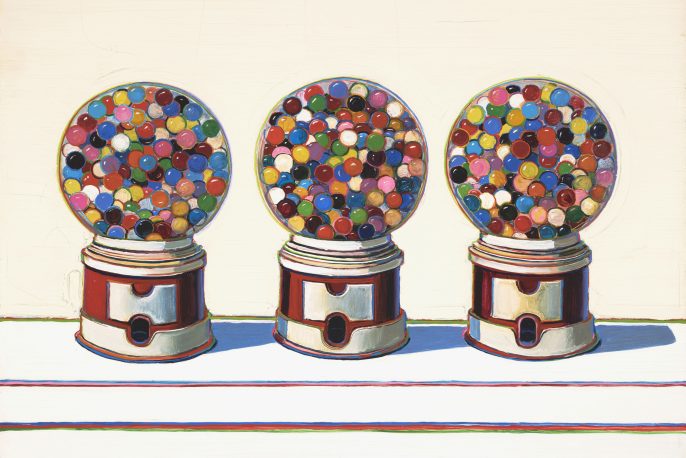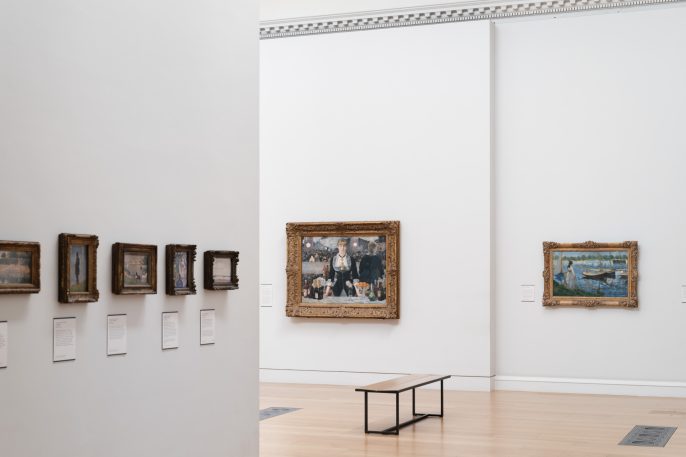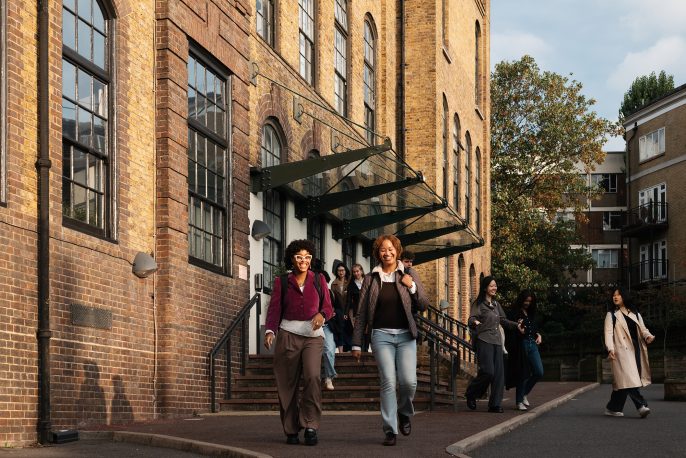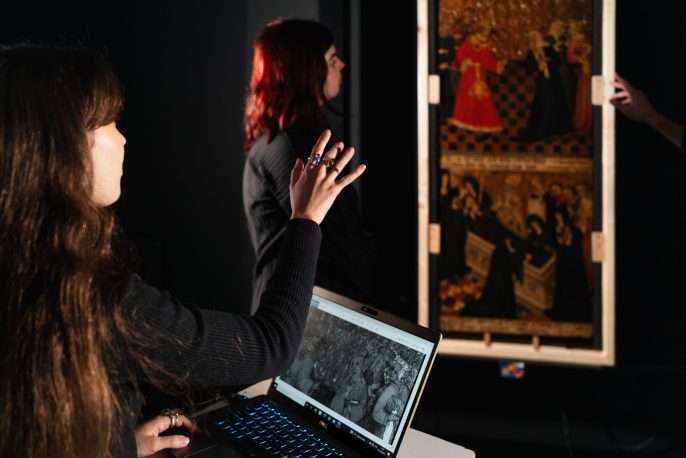The ‘Objects in Focus’ display in The Courtauld Gallery was curated by four postgraduate students from The Courtauld Institute of Art. The aim of the project was to research and display little-known objects from the Gallery’s collection of decorative arts. The objects were selected to form two displays in Room 5 of the Gallery; the themes were ‘Portraits in the Everyday’ and ‘Real and Imagined Nature’.
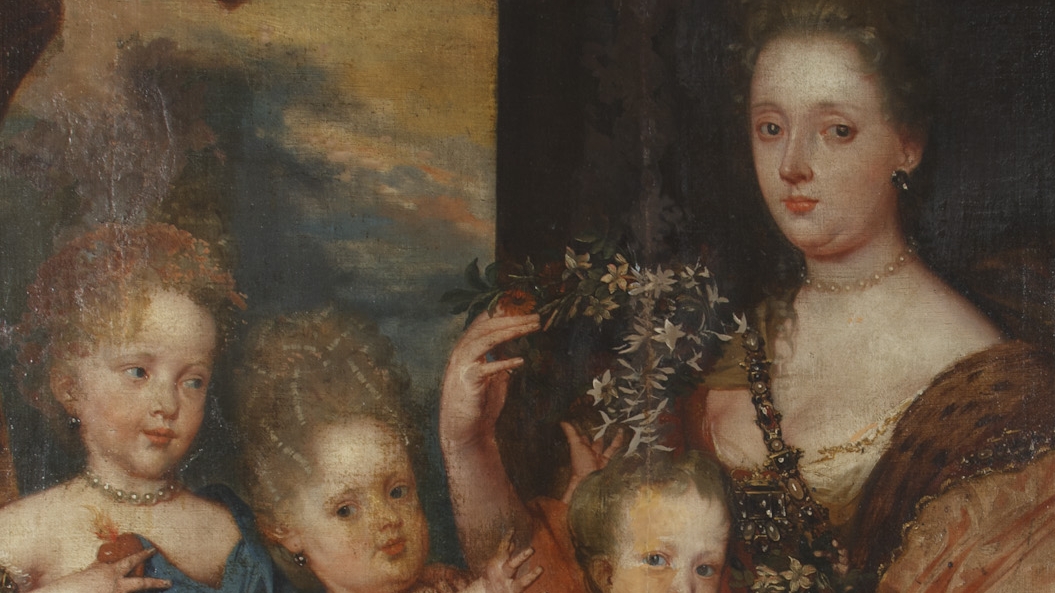
Painting Pairs: Art History and Technical Study
‘Painting Pairs: Art History and Technical Study’ is a research opportunity for graduate students enrolled in the MA in the History of Art, MA in Curating the Art Museum and the PhD programme. It is supported by the Research Forum, the Courtauld Gallery and the Department of Conservation and Technology. Selected students are given the opportunity to form a research partnership with future conservators from the postgraduate diploma in the Conservation of Easel Paintings.
Each pairing explores the contribution technical study can make to art historical scholarship (and vice versa) through research on a painting undergoing analysis or treatment in the Department of Conservation and Technology. The paintings are drawn from private and public collections, including the Courtauld Gallery. Past studies include: Portrait of Cardinal Granvelle by Scipione Pulzone, Toilet of Venus, circle of Veronese, Peter Lely’s Cimon and Iphigenia, Portrait of Francis Beaumont by an unknown 17th century artist, Carnival Scene at the Convent by an unknown 18th –century artist, and an examination of a 17th century copy of Raphael’s Holy Family.
Valuable experience is gained in the challenges and rewards of inter-disciplinary collaboration, which, although more familiar within a museum context, is becoming increasingly part of academic practice. Indeed, ‘Painting Pairs’ is at the forefront of initiatives that increase the links between technical and art historical enquiry and broaden the ways in which technical study can be applied.
Research is self-directed and a high degree of professionalism is expected. This is reflected in the fact that each participant receives an honorarium, with additional funds available if a study trip becomes necessary. Each pairing is required to set out their research questions at a workshop held in the Research Forum at the beginning of the spring term, and to present findings at a second workshop later in the year. Wider access to this research is enabled by the posting of a project report (submitted a week after the final presentation) on The Courtauld website. These collaborations can also lead to publications in peer-reviewed journals and the public display of paintings once confined to the storeroom.
2024-25 Reports
2023-24 Reports
Report: Grace Storey and Sarah Brokenborough, Mary Queen of Scots, Royal Collection Trust
Abstract: Childbirth Scene, Private Collection, Victoria Ward and Tiffany Foster
Abstract: Sakeenah Montanaro and Bianca Arthur-Hull, Portrait of a Lady, Parham House
2022-23 Reports
Report: Evelyn De Morgan, The Barred Gate, c. 1914-19, Alexandra Earl and Kaira Mediratta
Report: ‘I.M. Coope and the Old Iron Portrait Series’ Catherine Dussault and Chloé Glass
Report:Girl Reading ‘The Task’, Emma Wright and Elisabeth Subal
Abstract: Girl Reading ‘The Task’, Emma Wright and Elisabeth Subal
Abstract: Evelyn De Morgan, The Barred Gate, c. 1914-19, Alexandra Earl and Kaira Mediratta
Abstract: I.M. Coope and the Old Iron Portrait Series, Chloé Glass and Catherine Dussault
Abstract: Follower of Joos van Cleve, St. Jerome, Private Collection, Sophia Boosalis and Abby Li
2021-22 Reports
Abstract: Souvenir de guerre II, André Fougeron, 1975
Abstract: A View of Jamaica, attributed to George Robertson, c.1774
Abstract: A pair of pendant portraits by Sir Henry Raeburn in the Courtauld Gallery Collection
2020-21 Reports
Abstract: Sir Ralph Bosville of Bradbourne (unattributed)
Abstract: The Rite of Spring; Dionysus of the Dithyramb by Dame Ethel Walker
Abstract: Noli me Tangere by Ambrose McEvoy
Abstract: A Portrait of Her Lady and Four Children (unattributed)
2019-20 reports
Portrait of the Artist’s Wife by Albert Braïtou-Sala
16th century Spanish Panel Saint Blaise by Unknown Artist
Westwood Manor House and Church in a Landscape with Two Rustic Figures
2018-19 Reports
A group of sketches from life, attributed to William Etty
Infanta Isabella, attributed to the workshop of van Dyck
Interior Scene, attributed to an unknown artist (after Harold Gilman)
2017-18 Reports
Portrait of a Lady (1608), attributed to Robert Peake the Elder
Standing Female Nude / Landscape with Mountain Bridge (c.1910), attributed to Dora Carrington
Still life with Bust (1936), by Mark Gertler
Susannah Fanshawe (c. 1750), by an unknown eighteenth-century artist
2016-17 Reports
An Examination of La Ferme de la Californie, Attributed to Eugène Boudin
Figures in a Landscape-Flemish Panel Painting attributed to Valckenborch
Making and Meaning-An examination of Two Figures by Albert Adams c.1990
Workshop of Andrea Vicentino-The Raising of Lazarus. c. 1590
2015-16 Reports
Madame Manet In The Conservatory A Comparison Between Two Versions
Cymon and Iphigenia By an Unknown Nineteenth-Century Artist (after Sir Joshua Reynolds RA)
Landscape with washerwomen, attributed to Alessandro Magnasco
2014-15 Reports
‘Portrait of a Lady’ or ‘Portrait of Dona Joaquina Candado’ by Follower of Francisco de Goya
The Holy Family by Bartolomeo Montagna
Portrait of Francis Beaumont, c. 1610-25 by Anglo- Netherlandish Artist
Visitors to a Venetian Convent during Carnival by an unknown 18th-century artist
2013-14 Reports
The Toilet of Venus by Circle of Veronese
Cimon and Efigenia by Peter Lely
A Portrait of a Gentleman attributed to William Dobson (Please note this is currently unavailable – we hope to add it soon.)
Portrait of Cardinal Antoine Perrenot de Granvelle by Scipione Pulzone
2012-13 Reports
Nordic Beach by Percy Wyndham Lewis
Virgin and Child after Johann König
Assumption of the Virgin by Francesco Solimena (this report is not currently available)
The Virgin and Child Enthroned with Saint Michael and Saint John the Baptist Italian, mid-to-late fourteenth century (this report is not currently available)
2011-12 Reports
Copy after a self-portrait by Thomas Gainsborough Studio of Thomas Gainsborough (1727 – 88)
Trees by a lake, le Parc de Carrieres-St-Denis by André Derain
2010-11 Reports
2009-10: Objects in Focus
2008-09: Collecting and The Courtauld Collections
In December 2008, the Research Forum appointed five Research Associates to form a team to examine materials from the Witt Library and related to holdings in the Witt and Conway Libraries. The title of this project was: Record or Representation? Photography and the Artist’s Studio. Exploring the holdings of the Witt and Conway photographic libraries and the Rob Dickins Collection, this project examined the appearance of artists’ studios in paintings and photographs. Areas considered included the documentary value of photographs of studios of nineteenth- and twentieth-century artists (for example Barbara Hepworth and Jacob Epstein) found in the Conway, the conventions of representing the artist in his studio in paintings and photography (as recorded by the holdings of the Witt and Conway), and how artists represent themselves or stage their activities in paintings and photographs (as found in the Witt, Conway, and Dickins collections). This project revealed unexpected aspects of the Courtauld collections and produced new interpretations of the Dickins Collection, which is a major body of material relating to Victorian artists and their milieu. Giles Waterfield (who was preparing an exhibition at Compton Verney on the subject of artists’ studios) and Dr. Desna Greenhow (Watts Gallery) took part in the project . The Research Associates worked under the direction of Barbara Thompson and Dr Jane Cunningham. They presented the result of their research at workshops held on 16th March and 22nd June 2009.
The 2008-09 Research Associates were: Claire Brisby (PhD research on nineteenth-century Balkan icon-painters’ perception of western art ); Katie Faulkner (MA The Aesthetic Body: Science, Aestheticism and the Image of the Body in British Art 1860-1900); Joanna Milk (PhD ‘Visio Dei: The Iconography of Contemplative Vision in the Lives of the Saints in Tuscany, 1450-1500’ ); Gregory Salter (MA Modernism in Britain 1890-1970).
2007-08: Collecting and The Courtauld Collections
In December 2007, five Research Associates were appointed to the Witt Library and the Photographic Survey Department project entitled: Collecting and the Courtauld Collections; the theme continued that of the previous year. Supervised by Dr Jane Cunningham and Barbara Thompson, the Associates examined different topics, within the overall project, using materials from the Witt Library and the Photographic Survey Department, and explored the following areas:
1. Sir Robert Witt and his involvement in the development of the study of art history prior to the foundation of the Courtauld Institute. (Using the volumes of news cuttings from 1896-1928 in the Witt Library Archive and the Duveen Archive on microfilm).
2. The relationship between the building and collection at both Grimsthorpe Castle, Lincolnshire and Drayton House, Northamptonshire. (Using inventories and other documents held in the Photographic Survey Department and photographs from the Witt Library).
Research associates presented their preliminary findings at a lunchtime seminar in the Spring 2008 term at the Research Forum, providing insights into the Witt Library Archive and what it reveals about the art milieu of the first decades of the twentieth century. Associates also discussed the significance of the iconography and specific location of some paintings in the collections at Drayton House and Grimsthorpe Castle. Final reports were given at a lunchtime seminar in June 2008, with both seminars provoking a wider discussion around the findings of the individual researchers.
2006-07: Collecting and The Courtauld Collections
In December 2006 five Research Assistants were appointed to the Witt Library and Courtauld Gallery project on Collecting and the Courtauld Collections. They formed a research team examining materials from the Witt Library and related holdings in the Photographic Survey and the Courtauld Gallery. Supervised by Dr Jane Cunningham, Dr Alexandra Gerstein and Barbara Thompson, the research assistants explored the following areas:
1. Sir Robert Witt and the Witt Collection, 1931 (using the news cuttings volume from 1929-31 and the photographic collection).
2. Duveen, Witt and the Witt collection, 1931 (using the Duveen archive, available in the Witt and the Witt photographic collection).
3. A private collection (following the history of this collection, using inventories, the Photographic Survey and the Witt photographic collection).
4. Gambier-Parry and collecting between ca. 1850-1880 (using the archives in the Courtauld Gallery).
The five research assistants presented their preliminary findings at a lunchtime seminar in the Spring 2007 term at the Research Forum, providing insights into collections including those of Sir Robert Witt and Thomas Gambier Parry. Final reports were given at a lunchtime seminar in June 2007, with both seminars provoking a wider discussion around the findings of the individual researchers.
2005: Persistence of Antiquity
The Persistence of Antiquity Research Project was an initiative developed by the Conway Library and the Research Forum to explore the history and archaeology of the Conway collection. Four Courtauld research students – three MA students and one doctoral student – were appointed to Research Assistantships, funded by the Research Forum. The 2005-6 Getty Research Institute theme, ‘Duration: Persistence of Antiquity’, was adopted as a tool with which the Research Assistants could excavate aspects of the Conway Library collection.
For the first term, two students were asked to explore the attitude of Lord Conway, the founder of the collection, to antiquity and its later reflections. The other two were asked to explore photographs of contemporary buildings and sculptures which in one way or another represented the persistence of antiquity. In the second term, these themes were slightly adjusted and refined.
Katharine Higgon started her work on Lord Conway with an exploration of monuments and objects produced in the centuries after the fall of the Roman Empire, material with which Conway became increasingly interested. In the second term she focussed on Conway and the genesis of the collection, exploring Conway’s and Agnes Conway’s role in building up the collection of 19th-century prints of Rome. Her work led to a real understanding of Lord Conway’s working methods, in the context of the development of the subject of art history in Britain and Europe, to insights into how Conway’s collection was transformed when it came to the Courtauld Institute in the 1930s, and into the fate and transfer of early photograph collections in the early 20th century.
Katharine Higgon’s biography of Martin Conway
Seonaid Goody’s researches focussed on the classical sculpture holdings within the collection. She began by analysing Lord Conway’s, and his daughter Agnes’, own contribution in that area. In the second term, building on that analysis, she went on to consider how early approaches to photographing classical sculpture have contributed to the way that classical sculpture has been and continues to be understood, interpreted and discussed within the art historical discourse.
Hannah Parham worked on the ways in which photographers framed their images of contemporary buildings. In the first term she compared the visual responses of some 20th-century photographers to contemporary buildings which were classicising or modernist. The photographs of Robert Byron, in particular, proved a fruitful area of study. In the second term she extended this approach to analyse two collections of photographs: Charles Marville’s photographs of the new wing of the Palais de Justice in Paris, taken in the 1860s when the building was in the course of completion, and a fine set of photographs showing buildings of the Soviet State taken in the 1940s. Both sets show classicising buildings which represent the power of the state, and both sets were taken and distributed with clear political intent.
Silvia Loreti analysed photographer’s responses to the classicising and the classical. In the first term she explored the works of the early 20th-century sculptor Medardo Rosso, who used the relatively new medium of photography in both the creation and presentation of his own sculptures. She also showed how later studio photographs of his sculpture classicised his works and rendered them appropriate for appropriation by Mussolini’s Fascists. In the second term she explored the development of two iconic classical sites, the Acropolis and the Roman Forum, setting an analysis of their topographical development alongside an analysis of the way photographers between c.1850 and c.1930 responded to them, creating iconic images of place against an evolving topographical reality.
The students presented their researches Silvia Loreti’s report at two Conway workshop lunches, the first held on March 15th, the second on June 21st. Both were open to the research community at the Courtauld Institute; a few guest respondents were invited to the second workshop lunch. Both workshop lunches were felt to be very successful. The students ensured that their presentations were brief, leaving ample time for discussion. Discussion was lively and many complex questions to do with both collections and photographs were raised. It was felt that this initiative has provided new insights into the rich collection of collections which form the Conway Library. The students themselves have said that their work within the collection has enhanced their understanding of art history in its broadest sense.
